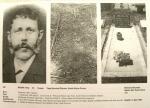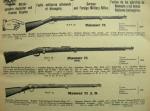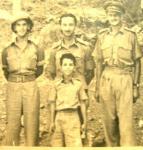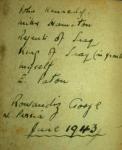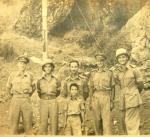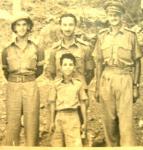-
Posts
13,225 -
Joined
-
Last visited
-
Days Won
22
Content Type
Profiles
Forums
Blogs
Gallery
Events
Store
Everything posted by Mervyn Mitton
-

VICTORIA CROSS 'MYSTERY'
Mervyn Mitton replied to Mervyn Mitton's topic in Great Britain: Orders, Gallantry, Campaign Medals
Although this has nothing to do with Brown, the next entry in the book was also for the engagement on Moirosi's Mountain and also, for a member of Cape Mounted Rifles. He is award number 384 and is Lt. Col. Robert George SCOTT VC, DSO. -

VICTORIA CROSS 'MYSTERY'
Mervyn Mitton replied to Mervyn Mitton's topic in Great Britain: Orders, Gallantry, Campaign Medals
From my volumes on VC awards, this appears to be all that is known about Peter BROWN VC. The photo is probably the only one of him, since I have found it used as the ref. in a number of books. The research notes show that he was awarded the 383rd. VC given out. The action was Moirosi's Mountain during the 9th. Kaffrarian War. He died in South Africa in Sept. 1894 of Bright's Disease - I think this is kidney's, so he may have had an alcohol problem ? He is shown as being born in Sweden in Dec. 1862 - hence Kim's question. Chief Moirosi was a known trouble maker who incited his tribe in unrest against the British in the Eastern Cape. The British Authorities sent an expedition to deal with him - however, he had been preparing a 'fortress' near the Free State borders and Basutoland. He retreated into this and as it was on a high hill , and he had stocked it with cattle, he was fairly impregnable. Two attacks were made on the mountain and both were driven back with losses. We used both 7lb. and 12 lb. cannons. Finally, it was decided that a night attack would be made and the main part of the Force were 350 men of the Cape Mounted Rifles. Trooper Brown was part of this Force - they attacked 8th April 1879. He was severley wounded but continued to help his comrades and was awarded the VC for his bravery. Sadly, he seems to have been buried in a plot in Capetown, that already belonged to someone - and there is , apparantly , no gravestone for him. The photos show the original grave marked out with sticks. Now, we come to Kim's question. Why is he shown as being of Swedish origins, but having a British surname ? I don't think this is a big mystery. During the second half of the 19th Century there were bands of people emigrating and roaming all around the World - basically, using the new freedom of easier transport to better them selves. Possibly, Brown was one of these people and first came to Sth. Africa with his original Swedish name. However, this could have been difficult to pronounce or, spell and I think it very likely that he would take a British name to fit-in. Also, it is very possible, that on joining the C.M.R. they just gave him a name for the rolls. If I am correct, then it may be almost impossible to trace him back - Rick may well have some thoughts on this ? What do other members think ? -
On Monday - hidden in a corner of the shop, we found a reprint of a 1911 arms catalogue. This shows both the rifle you mention and the ammo. Will add it to the thread. I had heard of this event but didn't know the details - interesting, and of course, Nation changing in their own way. I find all of this police history - both for the RIC and the RUC is of importance - I didn't attempt to cover it in the book as I thought it too complicated for just a chapter. However, I hope we can add as it all gives a clearer picture of events at the time.
-

Temperance Medals
Mervyn Mitton replied to Thomas Symmonds's topic in Great Britain: Militaria: Badges, Uniforms & Equipment
Hi - Don. Welcome to GMIC. Good to see some one else with an interest in these Temperance Medals - TT started a good thread with them. I agree with you on using a good camera, rather then a scanner - however, you will see in past posts on the Lounge, that scanners have a BIG following - I suppose it's really a matter of which you prefer.My posts are always by camera - Canon 1000 - and then Photo Impressions and Irfanview - I like that I can trim and edit the photos. -
Peter - looking at it again, you may well be right - it does look like UVF at the top. This makes it even more interesting - they couldn't have had too many made ? Do you think they also served as 'B' Specials ? I am hoping to have additional photos in the next few weeks - but, please tell us something about these landings ?
-
Peter - what excellent info. - some of the terms and the formation fire, I have never heard of. I suppose a forgotten subject that most of us have never absorbed. With your background in re-enactments you would of course, need to know. Are you still actively participating - it would make an excellent subject for a thread - particularly if you could tell about the unit you are following ?
-

SCINDE HORSE - WW2
Mervyn Mitton replied to Mervyn Mitton's topic in Great Britain: Orders, Gallantry, Campaign Medals
-

SCINDE HORSE - WW2
Mervyn Mitton replied to Mervyn Mitton's topic in Great Britain: Orders, Gallantry, Campaign Medals
-

SCINDE HORSE - WW2
Mervyn Mitton replied to Mervyn Mitton's topic in Great Britain: Orders, Gallantry, Campaign Medals
This is probably the most historic of the photographs - the boy in the middle is the King of Iraq and behind him is the Regent of Iraq. Capt. Gilbert is on the left of the King. The next photo will show the inscription on the reverse. I posted this photo on the Iraq site as I thought it would interest them - Paul told me the boy was assassinated in the 1950's. I will also show a close-up of just the central figures. The photo was taken in the ROWANDIZ GORGE in Northern Persia (now of course IRAN) in June 1943 -

SCINDE HORSE - WW2
Mervyn Mitton replied to Mervyn Mitton's topic in Great Britain: Orders, Gallantry, Campaign Medals
-

SCINDE HORSE - WW2
Mervyn Mitton replied to Mervyn Mitton's topic in Great Britain: Orders, Gallantry, Campaign Medals
Brigadier Aslam Khan - when he was a Captain and a friend of Captain Gilbert. Note the tanks in the background - are they Churchills ? -

SCINDE HORSE - WW2
Mervyn Mitton replied to Mervyn Mitton's topic in Great Britain: Orders, Gallantry, Campaign Medals
Brig. Aslam Khan was a captain with Gilbert and they were great friends. The original Scinde Horse had been the 14th lancers - from the letterhead you will see that they have become the 13 th. Lancers and are now a Pakistani Army unit. -

SCINDE HORSE - WW2
Mervyn Mitton replied to Mervyn Mitton's topic in Great Britain: Orders, Gallantry, Campaign Medals
-

SCINDE HORSE - WW2
Mervyn Mitton replied to Mervyn Mitton's topic in Great Britain: Orders, Gallantry, Campaign Medals
-

SCINDE HORSE - WW2
Mervyn Mitton posted a topic in Great Britain: Orders, Gallantry, Campaign Medals
Tony recently posted a small WW1 group - straightforward in itself - but with the incredible research and background information it quickly became of great interest. This is a similar group - standard five medals - showing service in Africa and Italy - but the unit and the information that came with it makes it - in my view - of great value to the collector. With the input from members it may also help to resolve a question that has been puzzling me since I got the group. Captain Maurice Lionel GILBERT was attached to the famous Indian unit - The Scinde Light Horse. They were originally formed in the 1840's and two regiments fought in the various campaigns of the Punjab. This was with the Hon. East India Company. After the Mutiny they were reformed as the 14th Lancers, but always retained the original name as well. Gilbert - at this point , must have been sent direct to the Middle East as he has no India GSM - or, Burma Star. Some of the refs. to him in later newsletters, indicate that he served in Iraq, Syria, and Lebanon. Also, the photos show that he was in Persia. These areas were of great importance because of their oil. The question that has been puzzling me , is that we have no Star to indicate service in these areas ? The Africa Star was really for the battles of North Africa and there is nothing else - and yet we had considerable numbers of men fighting in the Middle East for most of the War ? He probably went back to India at the end of the campaign - but probably too late for medals qualification. His family think he ended-up as a Lt. Col., but there is no evidence of this. Most of the photos are dated 1942 or, 1943. This photo shows him as a Lieutenant. Since they had become an armoured unit, his insignia are for the Tank Corps. -
Thanks Paul - had a feeling, that at that age, he wouldn't be allowed to live too long. Actually that's the history - of the whole area for the past 7000 years...
-
The interest today in Iraq seems to be mainly concerned with the current problems. However, this whole area has been in conflict for over 7000 years that we know of ! During WW2 the Allied Forces were very active in the area of Iraq, Syria and Lebanon - one such unit was the famous Indian, Scinde Horse - in tanks for the war. This picture will be part of a posting for the medals of Capt. M. Gilbert - (British and Commonwealth Medals) however, it clearly shows The Regent of Iraq and His King - only a boy at this time. Perhaps someone can give us details of this young man - and did he ever reign in his own right ? From left : Lieut. Mike Hamilton. Scinde Horse ; The Regent of Iraq ; The King of Iraq ; Capt. M. Gilbert, Scinde Horse. Taken in June 1943 at the ROWANDIZ GORGE, Nth. PERSIA.
-
I would not normally post a single officer's wings - however, these are a little out of the ordinary. You will see that the maker was in India and they are of a high quality with a brass backing plate. Naming details are - M.JALAL & BROS DRIGH ROAD (SIND) The officer was - AIR COMMODORE GEORGE SKELTON . I know nothing more about him - however, he must have been attached to the RAF Units stationed in India. I have never seen ref. to these makers before - has anyone else ?




